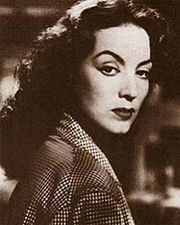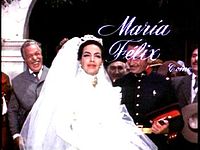- María Félix
-
María Félix 
Born María de los Ángeles Félix Güereña
April 8, 1914
Álamos, Sonora, MexicoDied April 8, 2002 (aged 88)
Mexico City, MexicoOther names La Doña Years active 1940–1971 Spouse Enrique Álvarez (1931–1938; 1 child, Enrique Álvarez Félix)
Agustín Lara (1943–1947)
Jorge Negrete (1952–1953)
Alex Berger (1956–1974)Children Enrique Álvarez Félix (1934–1996) María Félix (April 8, 1914 – April 8, 2002) was a Mexican film actress and one of the icons of the golden era of the Cinema of Mexico and also one of the myths of the Spanish language Cinema for her life style and personality . She was more commonly known, particularly in her later years, by the honorific La Doña.
Contents
Biography
She was born María de los Ángeles Félix Güereña in Álamos, Sonora, Mexico. There is some dispute regarding Miss Félix's date of birth. There is a large (but not unanimous) opinion that she was born on April 8, 1914, which means that she died on her 88th birthday. However, her obituary in The New York Times states that she was born on May 4, 1914, which would have made her 87 at the time of her death on April 8, 2002. Some claim her birth certificate supports the April 8, 1914 birthdate, although no actual evidence (such as a copy of either the birth or the death certificate) has been presented as concrete evidence[citation needed].
Family
Félix was one of twelve children born to Bernardo Félix, of partial Yaqui descent, and Josefina Güereña, who was of Spanish descent.
María Félix had one child, Enrique Álvarez Félix, by her first husband, Enrique Álvarez. Enrique Álvarez Félix was a Mexican telenovela actor. He predeceased his mother, dying in 1996.
Career
María Félix was discovered by businessman Fernando Palacios in Mexico City. Palacios presented with the filmmaker Miguel Zacarías, who would give him the opportunity of starring El Peñon de las Animas alongside Jorge Negrete.
In 1943 she starred Doña Bárbara, directed by Fernando de Fuentes and inspired in the novel of the Venezuelan writer Romulo Gallegos. De Fuentes increased her popularity with such films as La Mujer sin Alma (1944) and La Devoradora (1946); the latter making the actress the vamp of Mexican cinema in the 1940s. She reportedly refused to work in Hollywood unless she made her grand entrance from the "big door" and not the small roles offered by Cecil B. de Mille. Félix stated "I was not born to carry a basket".[citation needed]
She reportedly lost the only lead role of "Pearl Chavez" in the 1945 film Duel in the Sun, although it was written with her in mind, to Jennifer Jones, reportedly due to work commitments in Europe. As a result, she never achieved the fame in the USA that she achieved in Latin America and Europe. In 1946, she came under the influence of director Emilio Fernández, with whom she made the films Enamorada (1946), Río Escondido (1947) and Maclovia (1948), launched her career throughout Europe.
She worked in Spain in Mare Nostrum in 1948 and Sonatas directed by Juan Antonio Bardem. In France, with greats such as Jean Renoir (French Cancan,1954) and Luis Buñuel (La fièvre monte à El Pao, 1960), and played in Italian films like Mesalina (1951),alternating with stars like Rossano Brazzi, Vittorio Gassman, Jean Gabin, Françoise Arnoul, Yves Montand, Jack Palance, Fernando Rey, Francisco Rabal and others. In 1959, she starred the movie La Cucaracha, with Dolores del Río. In 1966, María Félix was given the lead role in La Valentina (1966), an adventure drama centering on the Mexican Revolution, where she sang the song "El güero aventao" with co-star Eulalio González. In later years, her films were inspired by the Mexican Revolution as La Escondida (1955), La Cucaracha (1959), Juana Gallo (1961), La Valentina (1966), and La Generala (1970), her last film.
Relationships
Her last husband was a French banker, Alex Berger, whom she married in 1956. Berger's company Monclova raced thoroughbred horses, achieving notable success with the colt Nonoalco who won four Group One races including the 1974 British Classic, the 2,000 Guineas. When Berger died in 1974, Félix inherited his multi-million dollar thoroughbred horse racing stable.[citation needed]
In music, art and fashion
Agustín Lara wrote many songs for her, among them the famous María Bonita. It has been recorded by many singers including Plácido Domingo. Other song writers also composed songs for her, like María de Todas las Marías by Juan Gabriel.
Félix was painted by many artists, including Diego Rivera, Leonor Fini, Leonora Carrington, Stanislao Lepri, Bridget Tichenor and Antoine Tzapoff.[1]
In 1949, Diego Rivera painted a portrait of her, which Félix classified as "muy malo" ("really bad"). This portrait; was originally intended to premiere in a retrospective on Rivera's work but Félix did not allow the painting to be displayed, as she never liked it. She did keep it for many years though, until she sold it to Mexican singer Juan Gabriel.[citation needed]
In fashion, Félix was dressed by designers like Christian Dior, Givenchy, Yves Saint Laurent, Chanel, and Balenciaga. The House of Hermès (Couture Department) designed extravagant creations just for her. She was a noted collector of fine antiques. She favored important pieces like her famous collection of Second Empire furniture. She was also a jewellery connoisseur and had an extensive jewelry collection, including the 41.37 carat (8.274 g), D-flawless "Ashoka" diamond. In 1968, Félix commissioned a serpent diamond necklace from Cartier Paris. The result was an impressive, completely articulated serpent made out of platinum and white gold and encrusted with 178.21 carats (35.642 g) of diamonds. In 1975, she again asked Cartier to create a necklace for her, this time in the shape of two crocodiles. The two crocodile bodies were made of 524.9 grams of gold, one covered with 1,023 fancy yellow diamonds, while the other was adorned with 1,060 circular cut emeralds.[citation needed]
Since Félix's death, these jewellery pieces have been displayed as part of The Art of Cartier Collection in several museums around the world. To pay tribute to the actress, in 2006 Cartier debuted its La Doña de Cartier collection. The La Doña de Cartier watch with reptilian links was created to impress by its wild look. The case of the La Doña de Cartier features a trapezoid shape with asymmetrical profile reminding a crocodile's head. The wristband of the watch resembles the contours of a crocodile in large, bold and gold scales. The La Doña de Cartier Collection also includes jewellery, accessories, and leather handbags.[2]
Filmography
Main article: María Félix filmographySources
Bibliography
- Felix, María (1994). Todas mis Guerras. Clío. ISBN 968-11-0556-7.
- Agrasánchez Jr., Rogelio (2001). Bellezas del cine mexicano/Beauties of Mexican Cinema. Archivo Fílmico Agrasánchez. ISBN 968-5077-11-8.
- Taibo I., Paco Ignacio (1986). María Félix: 47 pasos por el cine. Editorial Planeta. ISBN 968-406-283-4.
References
External links
- Maria Félix: "La Doña"
- María Félix at the Internet Movie Database
- María Félix at the TCM Movie Database
- María Félix official website
- Casa María Félix
- María Félix por siempre (Spanish)
- Maria Félix and the Cartier La Dona
- María Félix at Find a Grave
Cinema of Mexico Actors · Directors · Films A-Z · Cinematographers · Editors · Producers · Screenwriters Films by year 1896–1919 · 1920s · 1930s · 1940 · 1941 · 1942 · 1943 · 1944 · 1945 · 1946 · 1947 · 1948 · 1949 · 1950 · 1951 · 1952 · 1953 · 1954 · 1955 · 1956 · 1957 · 1958 · 1959 · 1960 · 1961 · 1962 · 1963 · 1964 · 1965 · 1966 · 1967 · 1968 · 1969 · 1970 · 1971 · 1972 · 1973 · 1974 · 1975 · 1976 · 1977 · 1978 · 1979 · 1980 · 1981 · 1982 · 1983 · 1984 · 1985 · 1986 · 1987 · 1988 · 1989 · 1990 · 1991 · 1992 · 1993 · 1994 · 1995 · 1996 · 1997 · 1998 · 1999 · 2000 · 2001 · 2002 · 2003 · 2004 · 2005 · 2006 · 2007 · 2008 · 2009 · 2010 · 2011

Cinema of Spain Actors · Directors · Cinematographers · Editors ·
Films A-Z · Score composers · Producers · Screenwriters 1897–1929 · 1930s · 1940s · 1950 · 1951 · 1952 · 1953 · 1954 · 1955 · 1956 · 1957 · 1958 · 1959 · 1960 · 1961 · 1962 · 1963 · 1964 · 1965 · 1966 · 1967 · 1968 · 1969 · 1970 · 1971 · 1972 · 1973 · 1974 · 1975 · 1976 · 1977 · 1978 · 1979 · 1980 · 1981 · 1982 · 1983 · 1984 · 1985 · 1986 · 1987 · 1988 · 1989 · 1990 · 1991 · 1992 · 1993 · 1994 · 1995 · 1996 · 1997 · 1998 · 1999 · 2000 · 2001 · 2002 · 2003 · 2004 · 2005 · 2006 · 2007 · 2008 · 2009 · 2010
1897–1929 · 1930s · 1940s · 1950 · 1951 · 1952 · 1953 · 1954 · 1955 · 1956 · 1957 · 1958 · 1959 · 1960 · 1961 · 1962 · 1963 · 1964 · 1965 · 1966 · 1967 · 1968 · 1969 · 1970 · 1971 · 1972 · 1973 · 1974 · 1975 · 1976 · 1977 · 1978 · 1979 · 1980 · 1981 · 1982 · 1983 · 1984 · 1985 · 1986 · 1987 · 1988 · 1989 · 1990 · 1991 · 1992 · 1993 · 1994 · 1995 · 1996 · 1997 · 1998 · 1999 · 2000 · 2001 · 2002 · 2003 · 2004 · 2005 · 2006 · 2007 · 2008 · 2009 · 2010Cinema of France Actors · Directors · Cinematographers · Editors · Films A-Z · Producers · Score composers · Screenwriters · Film festivals 
Films by year: 1892–1909 · 1910 · 1911 · 1912 · 1913 · 1914 · 1915 · 1916 · 1917 · 1918 · 1919 · 1920 · 1921 · 1922 · 1923 · 1924 · 1925 · 1926 · 1927 · 1928 · 1929 · 1930 · 1931 · 1932 · 1933 · 1934 · 1935 · 1936 · 1937 · 1938 · 1939 · 1940 · 1941 · 1942 · 1943 · 1944 · 1945 · 1946 · 1947 · 1948 · 1949 · 1950 · 1951 · 1952 · 1953 · 1954 · 1955 · 1956 · 1957 · 1958 · 1959 · 1960 · 1961 · 1962 · 1963 · 1964 · 1965 · 1966 · 1967 · 1968 · 1969 · 1970 · 1971 · 1972 · 1973 · 1974 · 1975 · 1976 · 1977 · 1978 · 1979 · 1980 · 1981 · 1982 · 1983 · 1984 · 1985 · 1986 · 1987 · 1988 · 1989 · 1990 · 1991 · 1992 · 1993 · 1994 · 1995 · 1996 · 1997 · 1998 · 1999 · 2000 · 2001 · 2002 · 2003 · 2004 · 2005 · 2006 · 2007 · 2008 · 2009 · 2010 · 2011
Categories:- 1914 births
- 2002 deaths
- Golden Ariel Award winners
- Ariel Award winners
- Commandeurs of the Ordre des Arts et des Lettres
- Indigenous Mexicans
- Mexican actors
- Mexican artists' models
- Mexican businesspeople
- Mexican film actors
- Mexican people of Basque descent
- Mexican television actors
- Golden Age of Mexican cinema
- People from Álamos
- Cardiovascular disease deaths in Mexico
Wikimedia Foundation. 2010.

